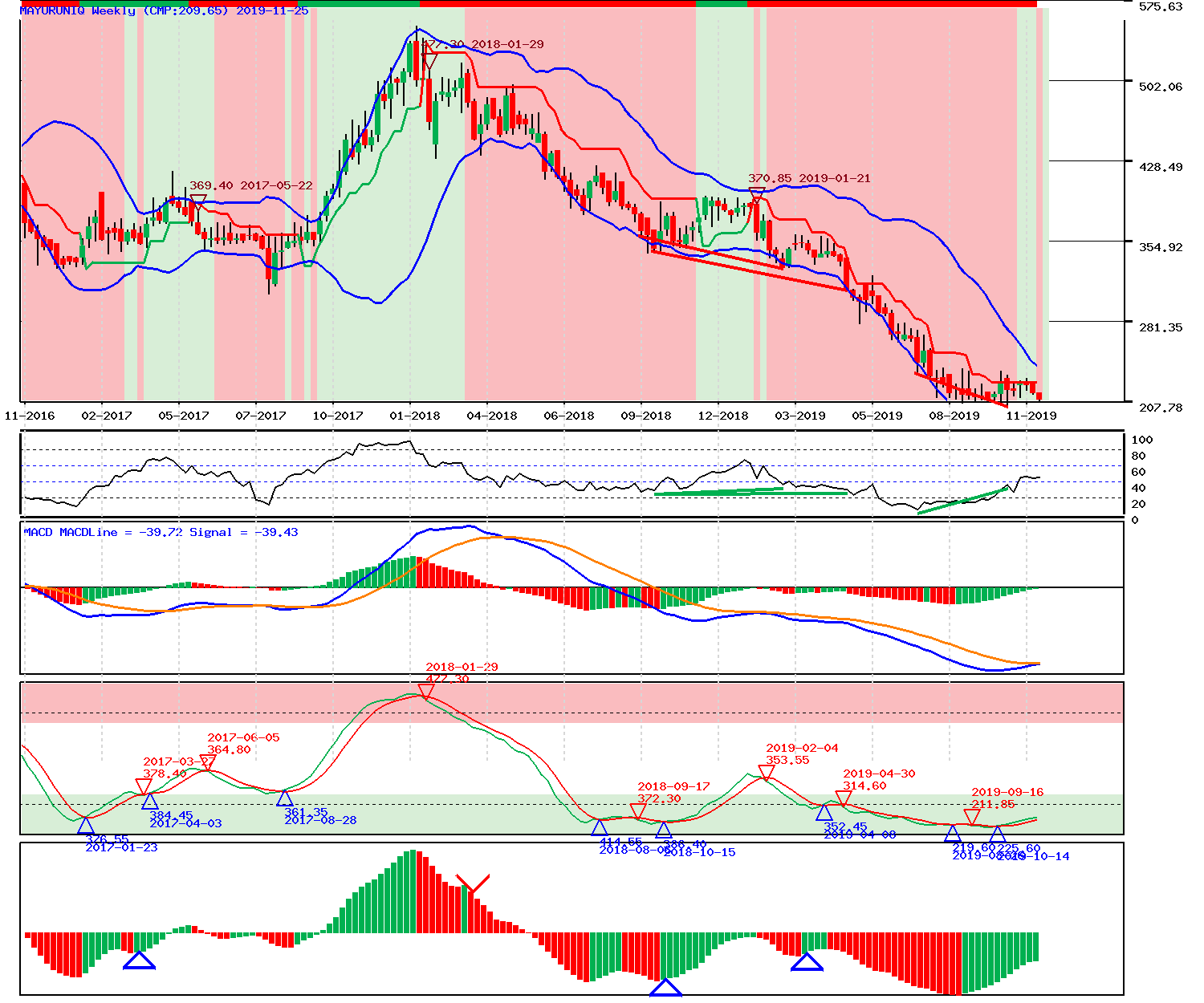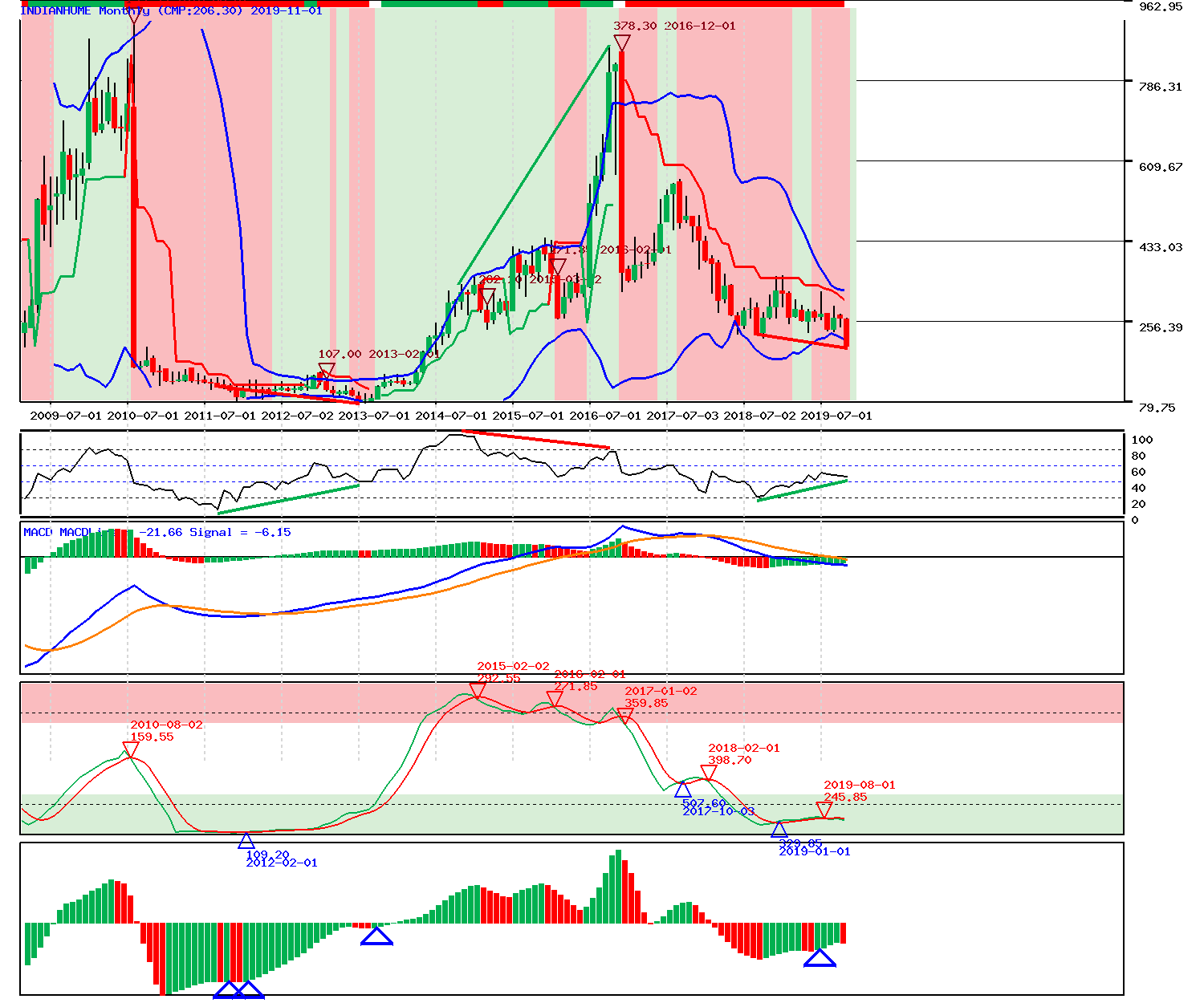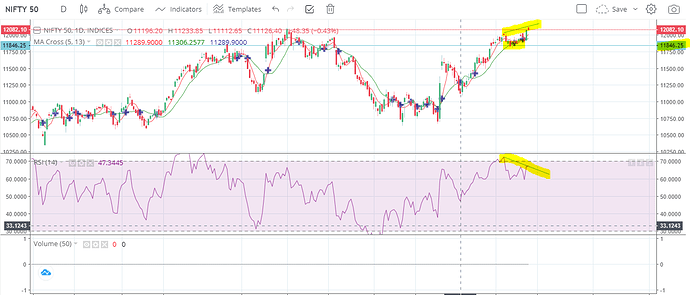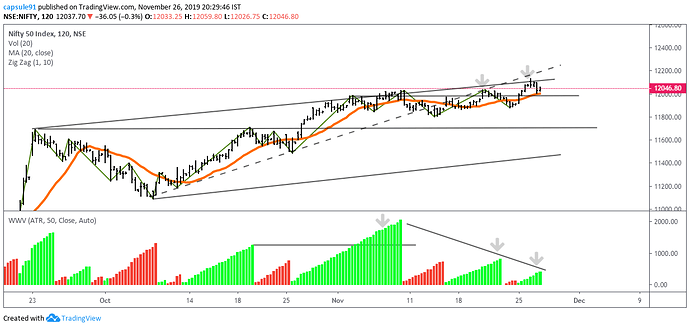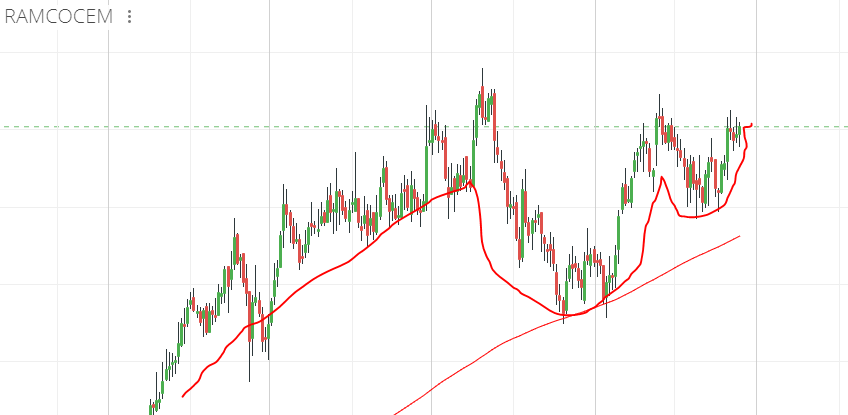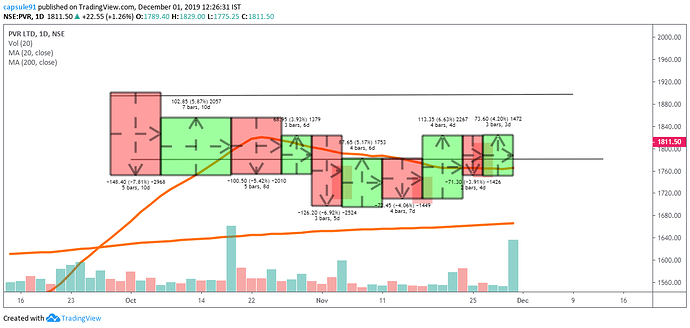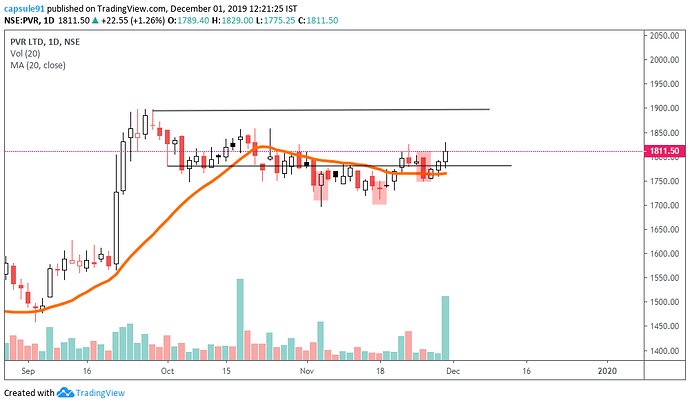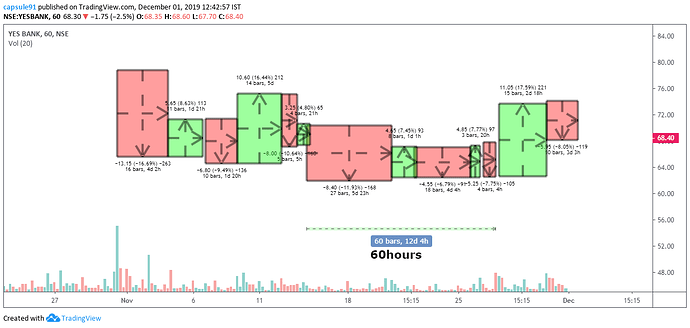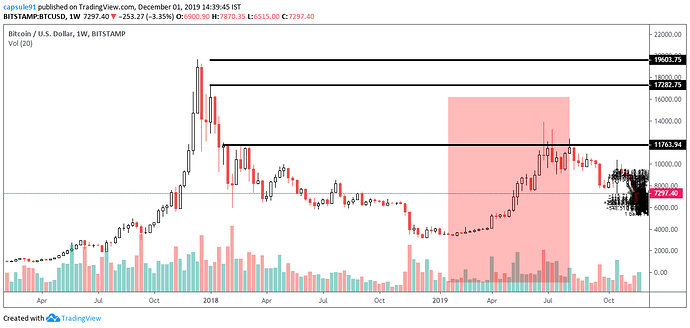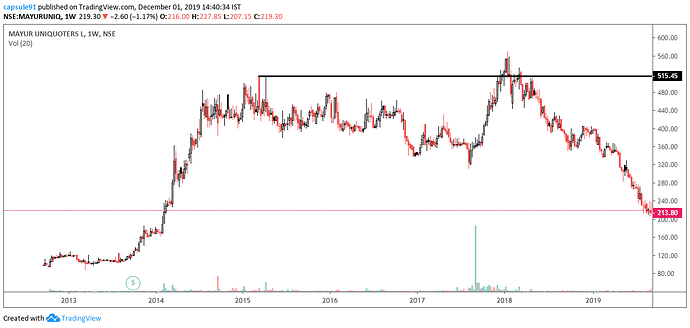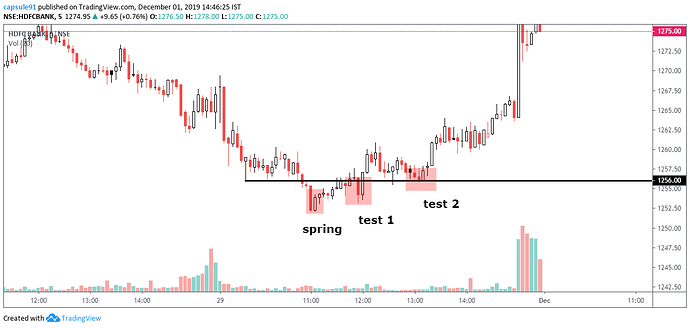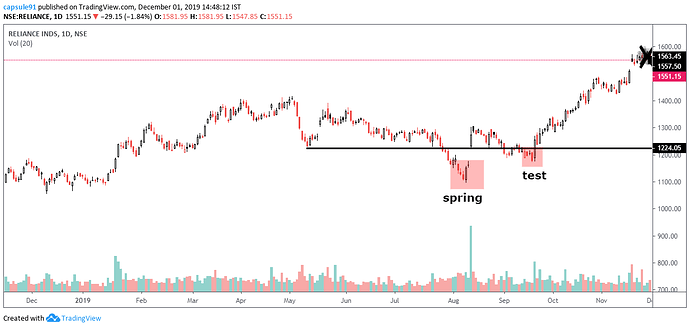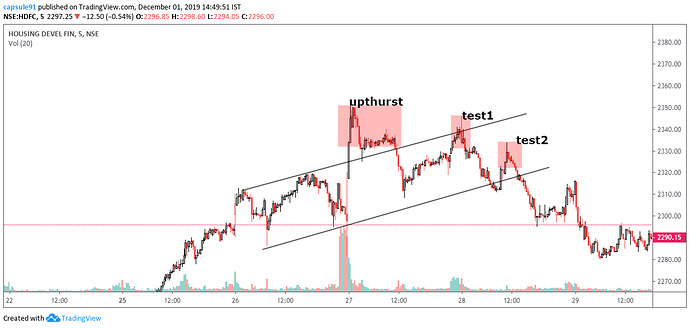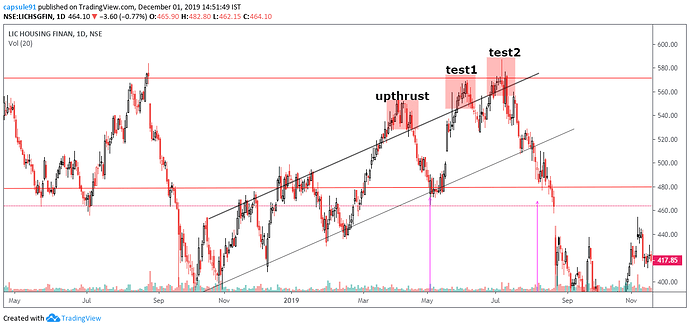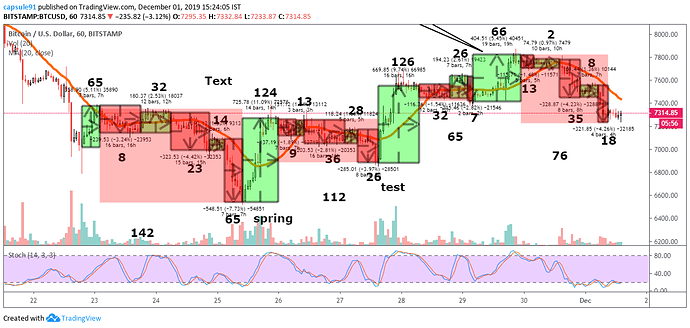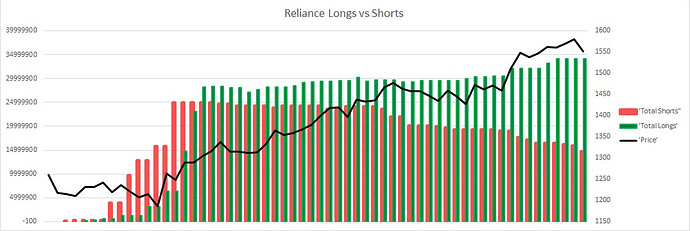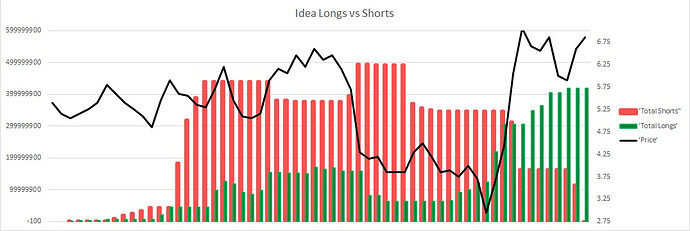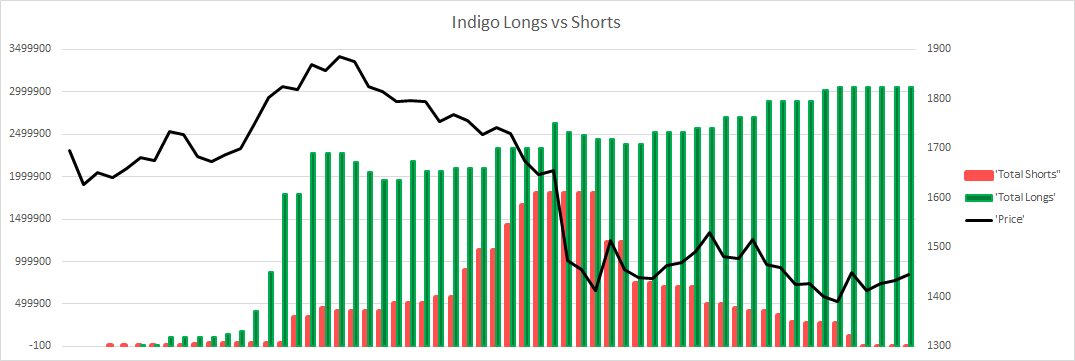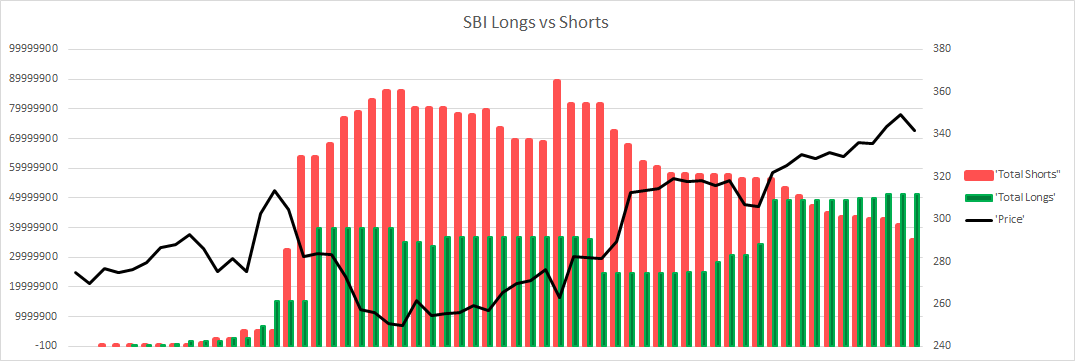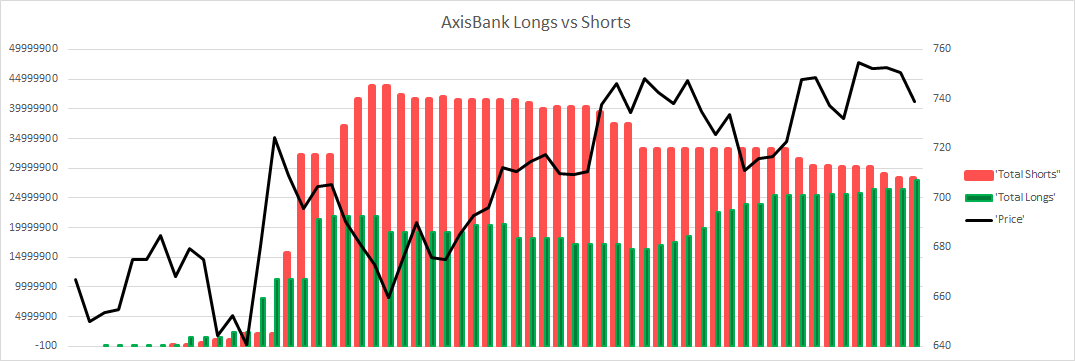IT is very much evident on weekly charts
Indian hume pipes if stop falling around this area then it is showing RSI +ve divergence on monthly charts (showing such pattern on monthly charts is big thing … see the past chart that it was worked earlier)…
For investor wait for a month more to confirm this before any investment …
A clear cut diversion on the daily chart nifty…it might come down to 11850 again in next few sessions.
nifty50
a dissection into the half day chart
bearish view…
the bottom indicator is just the weis wave which calculates the swing volume and plots the histogram
-
price has barely progressed in November series so far, the action has stuck to the supply line thoughout, making just 3% odd gains , without testing the supply …
lack of upward movement, at the same time no interest in supply check [secondary test]…
very suspicious what the composite operators are building the cause for -
a demand line can be drawn across the lows, as mentioned in dotted…
last 2 upswings failed to maintain above it, rather has started taking supply from it…
evidence of trend exhuastion -
looking at the weis wave panel, novement early, so a good momentum from the price… it was the highest upswing effort the price action displayed in last 2 months…
but although it has started to make highers lows and highers highs after that, can be called a trend, but i am not convinced looking at the result of the upswing…
this is a judgmental statement, i definitely see an effort vs reward mismatch in movement -
point 3 get reinforced, because the 2 upswings after that had very poor quality of demand… specially compared to October and early November rally…
conclusion…
- momentum exhaustion
- poor market breadth
- suspicion of the composite group selling into this trend
- excitement regarding q2 earnings [ have been a engineered upswing in market mood via media by the composite group] and the numbers thereafter failing to excite the institutions?..
- poor risk reward
bullish view [short term]
the contra view to the above picture would be …
pitchfork used because , the market is volatile, not trending in the weekly chart, relative strength in between swings can be well analysed
andrew pitchfork is used on a older swing
schiff pitchfork is used on a more recent swing
- the present action broke took resistance from the median line of the andrew’s pf, and broke below the demand line, and is currently retesting it… no upward action has been seen yet but the positive build in this is the fact the last 3 week’s bar had poor close, maintained above the 18’ august high and r1 resistance, some local absorption of supply might be there
2.the supply line of the schiff pitchfork has higher than the current price action, near the r2 resistance which is roughly at 12600
so there might be some more headroom for over extension of the current move…
the price action in the last 24 months havent sustained beyond 8% deviation from the 20 weekly moving average, it is present 6% above it…
disclaimer… i am bullish on the longer term picture on the index, yet, expecting short term weakness… indices around the world has topped out, and i am very interested to see how much supply comes in and the quality of it, in terms of effect on price action…
Ramco cement cup and handle pattern on weekly charts.
@hitesh2710 ji - your thoughts?.
Have a question about candlestick charts in TradingView.com
I cannot find a way by which I can adjust both the length of the chart & also duration of the candle.
I mean, if I adjust the duration of the candle (i.e. 1 candle represents 1 hour or 1 day or 1 week), then the length of the chart (whether the chart shows all the candles for 3 months or 6 months or 1 year also gets auto changed to fill the chart.
For e.g. I want to see a weekly candle (1 candle = 1 week’s OHLC) for 6 months.
If I choose Week option from the top panel, then length of the chart automatically expands to start from 2011 on till today. If I choose 6M in the bottom panel, then the candle duration automatically changes to 2Hour candle.
Is there a way to adjust these independently? Or is there a better site or software where I can do this?
I am using the free version.
Unfortunately no, the chart dosent filter data like that in TV, all u can do u scroll Zoom and be in your time period…
I have seen sites like stockcharts have the feature you are saying, but I believe the free version of it is very difficult to work with, specially after being habituated with TV
Say i’m seeing a chart in Weekly timeframe. It shows from August 2017. Now if i choose the Daily timeframe from the top drop down, then it shows from May 2019.
If I want to see the chart from August 2017 in the daily timeframe, I just use scroll wheel on the mouse to get the candles in a tighter graph inside the monitor space.
That should solve your problem … i think if i understand it correctly.
sellers ineffective in pvr
this is a swing chart which i make to visually appreciate the demand supply quickly, a derivative of weis wave, which i am currently working on developing…
first marked box one was a spring, second was a test of the spring region, with good jump across the 20dma, the third was another secondary test which failed to follow through
disclaimer… accumulating
i dont see much supply in yes bank
28days have passed since the price action had a climactic stop, supply has come in since, and the price fails to correct beyond 38%…
who do u think is supporting the price? … institutions…
a view of what is happening in the price action since the last 28days
of special interest to me, for 60hours the price failed to make a new low, and the headlock was broken by a bullish action…
disclaimer… have positions in futures, not an investing.trading recommendation
Try with another mouse. Works with me, older as well as new mouse i’ve had since I started TView.
1st december was an important day in my journey in money markets…
i was introduced to technical analysis in 2017 around this time…
i would like to summarize my learnings from technically analyzing the market after almost learning and testing all the available trading methodology in the book…
learnings from specific school of methods…
-
candle stick pattern… only charting method with an array of patterns…
advantages- helps to spot reversals and continuation of a trend
disadvantages- sensitivity deceases lower than daily timeframe, specificity maintained in any timeframe though -
bar chart- reduces forming a biased opinion about price action on visual interpretation, the representation on open and close is such that one has to strain eyes into a specific bar to know about it, result- more focus on price action, less of a bias formation, clustering of open and close at the top and bottom of a trend is visually appreciable easily, shifts an analyst view towards spread of a candle thus of good use in volume spread analysis
3.heikenashi- a noise free chart , great for keeping the mind at ease, but has the most lag in spotting reversal of the 3 charts so far
4.renko- noise free, has no x/time axis, has most lag of all charting methods, but reversals are most confirmatory of all other charts
5.kagi-- similar purpose but with lesser lag, and more noise compared to renko
i find volume analysis on kagi is an excellent way to build analysis on the demand and supply scenario
6.point and figure chart… lag is similar to kagi at reversals, but 2 best purpose of this chart is to spot accumulations and distribution areas and triangle formations and to calculate price targets bsed on the horizontal formations[which is a very accurate method]
7.indicators…
momentum indicators…[those i am familiar with]
class1… price derived…
rsi, stochastic, stochastic rsi, macd, fisher transform, cci…
most lag/lease noise-macd
least lag/most noise-stochastic rsi
among these, i have found rsi is the most versatile momentum indicator, it has a support, resistance, pivot system of its own, can be used with trendlines and reverse trendlines and moving averages…
for a bull market the thumb rule is ossilations between 80-40, with mean at 60
for bear market- 20 to 60, with mean at 40
a rapid movement across 40-60 range is generally sign of a change of trend/ shakeout/upthrust
i find stochastic is the best crossover oscillator, which can help with entry and exits…
i rarely make an entry unless stochastic is oversold and has a favourable crossover and viceversa
divergences are best and earliest picked up in oscillators with more noise, stoch, stoch rsi, cci, fisher transform
class 2… volume derived
obv, netvolume index, cumulative volume index
prefer to avoid this category as their yield into analysis is low
class 3… price and volume integrated indicators
chaikin money flow and klinger oscillator
i have considerable experience with klinger oscillator, and it is very effective in confirming reversals, spotting divergences in momentum, exhaustion of a trend, spotting relative oversold and overbought levels, only disadvantage is that, the interpretation time is a bit, which on itself will introduce lag in the system.
chaikin money flow is inferior to klinger in every ways possible
a note on indicators…
for a beginner momentum indicators, are the only tunnel with light at the end, everyone should use them to crack into the maze of price action, but with time, dependency on them should be reduced and more focus on the price and volume be applied, and just keep indicator as a last tick off a checklist while taking a trade. The reason for this is, the only live action in the market is price, the volume of transaction leading to a price and the clock… those 3 are the best indicators possible…
coming to a few trading systems…
lessons in summary [which i cherry picked to build my own strategy]
- bollinger bands- price action is a expansion and rarefaction cycle, having a standard deviation mark from the mean of price action, is effective in knowing the risk potential of a trade based any any given point of time on the relative width of the SD limits.
2.ichimoku- just reaffirms the importance of moving average of a price, it is a very complicated system on itself, i would rather prefer moving averages and support resistances than putting a 6parameter indicator on my chart and introducing more difficulty in analysis…
3.moving average…
this is a vast topic, i find the 20simple moving average as the most sensitive and specific one in any time from from 1 mins to 1month…
i have pledged myself, never to enter a long unless the 20ma is tested positively and the action is above it and vice versa for short
a cross over between 20 and 50ma on any tf, is a very good indicator of a local change of character of price action relative to a longer trend/action history
another interesting indicator is a moving average deviation… it has a visually appreciable contraction and expansion cycle, nugget is that it works best on weekly and monthly tf, and can very accurately signify a dying trend or a budding one… trading view has an excelelnt indicator on MA deviation
4.harmonic… i was fascinated with this system once, conclusion is, it is a very good system in volatile markets like forex and lower time frames [sub daily], has excellent accuracy with entry and exit guides… i sometimes use harmonics when formation happens in my chart, in a reverse way, if a bullish/bearish harmonic fails to follow through and it is most likely a case of redistribution/reaccumualtion in a trend respectively… in forex market, i have seen professionals use harmonics a lot
5.elliot waves… this is a system i didnt go much in depth , as it was taking me far from the market and into the maze of possibilities and probabilities… basic lesson, price moves in 3 impulsive wave upwards and 2 retracements, wave 1 3 and 5 are impulses 2 and 4 are retracements… and this goes on in a bull market in concentric pattern, like 5 waves completed means wave 1 of a bigger cycle completed and so on…
handy tip from this system is, to check for atleast 1 major upwave in a price action after a consolidation , and to avoid entry if 3 major upwaves have been completed, in a bull market scenario… explaining about this system itself gives a headache… i try to use this kind of wave theory as least as possible…
but the best learning i had from EW is the importance of fibonacci series…
corrections failing to go beyond 50% of the upswings are generally temporary pauses.
a correction which dosent have much downward movement in price most commonly does time correction with limit at 38.2% of the last upmove[% drop from the high]
a correction failing to hold atleast 61.8% generally speaks of a major end in trend, i have noted hitesh sir in his thread, mention a number of times to wait before getting into scrips which has had sharp correction form the top and appears cheap, if nothing else, these generally cost us opportunities if not in price
- wyckoff methods…
i have mentioned a lot how this method analyses the price action, so the basic point here is to look for demand and supply… every action in the market is governed by instituions, and what we see are their foot prints… difficulty in it is how they disguise their motive…
7.pitchforks…
2 most commonly used forks are Andrew and schiff, these forks basically take a 3 pivot point reference from a swing like a high, low and a subsequent high for a bearish projection, and low high and a subsequent low for a bullish projection…
What it means in context is, a V represents a retest of high and if fails, would produce a bearish change of action and vice versa, pitchforks then project the trend that is likely to follow… There are 2 line category, median and extremes, the rule of thumb is, action is always pulled toward the median like of pitchfork like a magnet, and once that has happened the action is pull towards the extreme lines like a magnet…
Very usable tool for swing traders, personally how ever, I feel. More comfortable with horizontal line, moving average and trenline support resistances…
Somehow I feel pitchforks and these don’t make a homogenous mixture…
to sum everything up, the present basket which i have integrated everything into is as follows…
2 basic segments
trade analysis[1.demand supply, 2.support resistance, 3.price behavior] and trade psychology[which is subdivided into 1.entry 2.in trade 3.exit]
tradeanalysis…
1.demand supply…
3 components here… 1.price movement 2.volume/effort leading to the movement 3.time duration of movement
price movement is the base, and other 2 are confirming indicators
as a rule of thumb [might change context while incorporating supp/resis]
Any large movement if confirmed by volume and good dominance of time is a true movement
Any price movement confirmed by volume but completes in a small time duration, should be confirmed by the movement, volume and duration of the correction that follows a move[a small move, with low volumes, and small duration is an idea confirmation of the upmove to be a true one ]
Any time movement confirmed not confirmed by volume but by time is a paradox- this indicates ease of movement in a particular direction, in case of a upswing, the sellers are exhausted and supply in the market is absorbed into strong hands, hence it is the demand which drives the prices up, in such a scenario the volume should be low, and is a true movement
i think the principles of a false move can be worked out easily from reversing these criterias again, a large move in a particular direction, which might be confirmed by volume and time, but fails to make a mark, above the resistance, is a potential upthrust
an example… when bitcoins moved form 4000$ to 14000$ odd, in a matter of months , produced heavy volume, but failed to clear any of the resistances…
a textbook upthrust
any move in a particular direction must be confirmed by inability to follow through beyond a broken support/resistance, is confirmed as a true move
coming to price behavior…
all the rules of demand and supply is broken when it comes to springs and upthrusts…
spring…
a test of supply below all the previous lows, which is quickly reversed back and fails to follow through
upthrust…
a test of demand above all the previous highs which fails to follow through and is quickly reversed back
all springs and upthrusts are most commonly retested and the test if successful generates even a bigger reversal…
for example…
although this is from my day trading chart, but it appears across all time frames
but this is the classical textbook action
textbook upthrusts…
sometimes if the momentum is very high, the operators enjoy testing higher than the upthrusts, but the clue is, that each of this move will retrace the thrust fully back down beyond 50%…
david weis in his book had written… one could make a living trading springs and upthrusts
they are that powerful
some times spring action might appear at important places in the trend , not necessarily at the lows…
a very recent example.
although i had a bullish bias on the 2hrly chart,
but i was monitoring such micro time frame to make a good entry
i was bearish on the price action over the weekend, the reason is, the last session ended with tremendous volumes, but the upward movement above the previous high was not much and my theory was there were sellers who were selling this move…
which might have been correct?! the first 5 mins of the market open, formed a massive bearish candle, but closed above the 20ma on the chart, the next on also failed, and then came the spring action, and we knw what happened later on in hdfc
the bears were completely capitulated in the first 5mins that day…
after trade analysis, i try to come to a conclusion what the bias of the price action is at the moment and then comes trade psychology…
i try to keep entry rules as simple as possible but maintain a strict check list
rules…
- entry at 20ma
- entry at stoch crossover in oversold /overbought level
3.entry at second correction after a test of 50% level
5.entry at retest of broken resistance/support
checklist…
1.action above 20ma? yes
2.am i going against the market?no
3. a spring/upthrust seem already? yes
4.am i gambling? no
5.any resistances near my breakeven level ? no
6.will i have to check price closely? no
7.stoploss would generate a downdraw more than 10% of my monthy profits? No
8.stop hunt done? yes
while in trade i have try to monitor, one check
higher lows in a uptrend/ lower highs in a downtrend? yes
for exit depending on the type of trade, the technical POV is activated…
if it is a scrip that i have held since a long time, if comes in my rotation point range of a point and figure chart, i exit it…
if this is a positional trade, i keep raising my stops according to the average swing of a particular scrip, if a scrip swings 5% before continuing a trend, i prefer to keep the stop at just below the largest of average swings, helps to continue a trend with minimum risk…
manual closure of trade is always done, if action goes oversold beyond the support of a downtrend channel, or overbought beyond the resistance like of a uptrend channel
for smaller tf trades, pivot points are the best guide i have learnt to take quick profits off
with time, i have tried to become ruthless, if a trade goes wrong and badly goes against me after entry and nears my stoploss, i try to end the trade manually, more often than not, my stoploss gets hit, it rarely happens market surprises me after a wrong trade…
lastly, regarding volumes, a swing volume is more important that local volumes, for example a swing on 10 candles, should have all their volume added up and analysed, rather than looking at the pattern, this is what weis wave is all about, and it has formed a central analysis tool in my chart… local volumes only mater in areas of spring upthrusts and tests of those areas…
challenges and future interests…
with everything at hand, the biggest problem that i face and if i may, the only problem i face is my mind… its a 2 edged sword… a bipolar instrument… between losing money in greed and not making money in fear, and making money when others are fearful and caution whe others are greedy is easier said than done… a mental discipline is what i still struggle and aspire at… i have managed to make excellent losses, in entirely correct analysis as a result…
i wish to study and observe and practice judging demand and supply scenario in the market, viewing this in analog and visual colors and boxes and finding the right combination of it is current area of interest,
after having gone though most of the systems available, i have made a full circle to the basics of price action and volume…
i had tried self learning gann square and theory, but to no usable condition, will look forward to learn from someone well versed with it, i have been amazed with the accuracy of the analysis from those practice it.
i have been waiting for an opportunity to trade in bitcoins and finally got one on my recent trip abroad
the takeover of demand following the spring action was visible, a entry post test was initiated, and closed after shortening of thrust…
this is my present take on all i have learnt in technical analysis, this applies to all time frames, those specific to day trading or short term trading have not been mentioned as they are impractical for a person with a longer term view…
quoting a fellow member of this forum,
“its the market’s job to make me money, my job is to manage risk”…
hope this helps!
Wanted to introduce new charts of Futures Open interest to this thread. The chart is simple prices vs the Open Interest. The open interest is marked as short/short-covering or long/long-unwinding in the following cases
Price up OI up == long position
Price down OI down == long unwinding
Price down OI up == short positions
Price up OI down == short covering
Based on the above formula, each day based on the Price and OI whether moved up or down I mark the data accordingly. In case the OI increase and price drops then I mark that data to the “short built up” and add that day’s OI to “Total shorts”, I deduct the OI from total shorts, if price increases and OI drops (short covering). Similar for long positions (Total Longs)
Below is the chart of PEL… you can see the shorts increased dramatically and kept on increasing and the price kept on dipping. When shorts peaked… the price recovered (with no increase in longs) just because of pure short covering.
Keeping other charts open for study and interpretation
Thank you. I don’t know much about TA beyond simple patterns and my question was whether it’s a head and shoulder pattern in YB?
Bearish Cypher Harmonic pattern seen on SBI
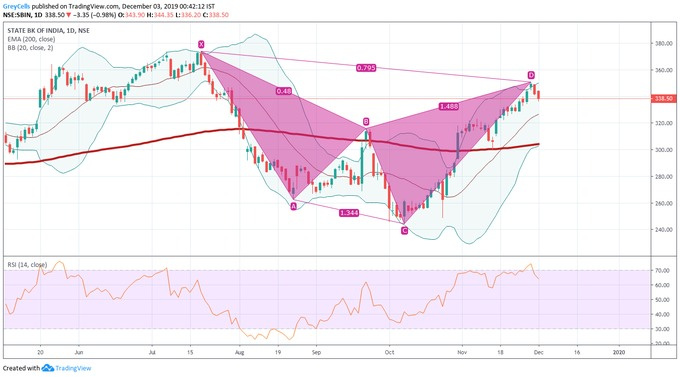
Long unwinding also seen in SBI recently
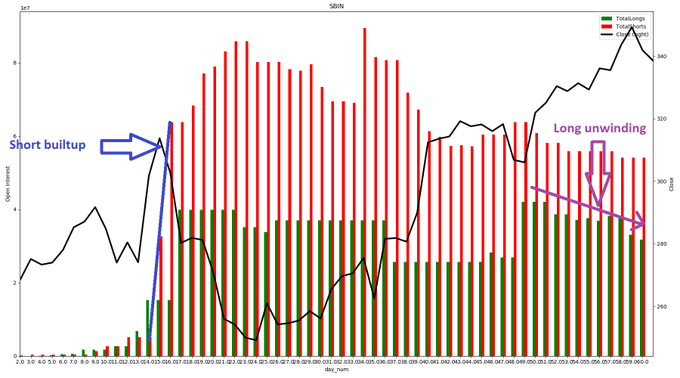
A sharp short built-up will confirm the trend
Hi Amol,
Could you please tell what resource you are using to get the Short and Long Charts.
Regards,
Kapil
I thought for derivatives, long and shorts need to be equal. HOw do you get different values for total shorts and total longs ?
New to technical analysis - so forgive me if this question is naive.
When looking for patterns like Head & Shoulders in a daily chart (not intraday) - what kind of chart do you use - a candlestick chart or it a different kind of chart - if something like just a line chart - what points are used on the line chart - is it a chart of daily high prices or daily low prices or daily Open or daily close?
None of the books I have been going through talk about this - they all have diagrams which look like a line chart (rather than a OHLC bar or candlestick) but none of them say what are the points on the line.
Check this link to get historical data
https://www.nseindia.com/products/content/derivatives/equities/historical_fo.htm
That is a wrong understanding.
Plus understand my calculations of Total Longs and Total Shorts
Based on OI and Price has increased decreased I add the open interest added that day to Total Longs or Total Shorts. For example if Price is down and OI is up or down I add that day Change in OI to Total Shorts.

